Which Azure Data Factory components should you recommend using together to import the daily inventory data from the SQL server to Azure Data Lake Storage? To answer, select the appropriate options in the answer area.
NOTE: Each correct selection is worth one point.
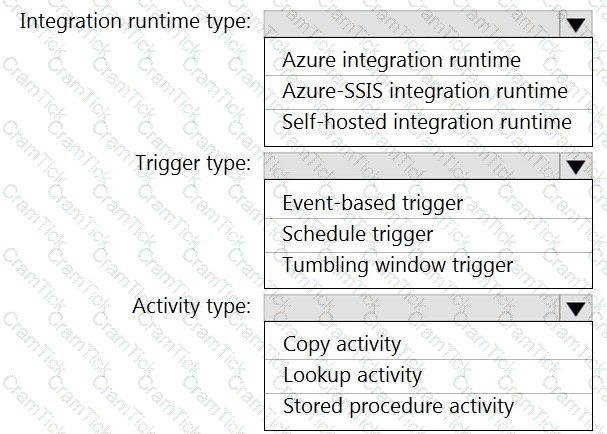
What should you recommend using to secure sensitive customer contact information?
What should you do to improve high availability of the real-time data processing solution?
What should you recommend to prevent users outside the Litware on-premises network from accessing the analytical data store?
You have the following Azure Data Factory pipelines
• ingest Data from System 1
• Ingest Data from System2
• Populate Dimensions
• Populate facts
ingest Data from System1 and Ingest Data from System1 have no dependencies. Populate Dimensions must execute after Ingest Data from System1 and Ingest Data from System* Populate Facts must execute after the Populate Dimensions pipeline. All the pipelines must execute every eight hours.
What should you do to schedule the pipelines for execution?
You have an Azure Synapse Analytics dedicated SQL pool that contains the users shown in the following table.

User1 executes a query on the database, and the query returns the results shown in the following exhibit.
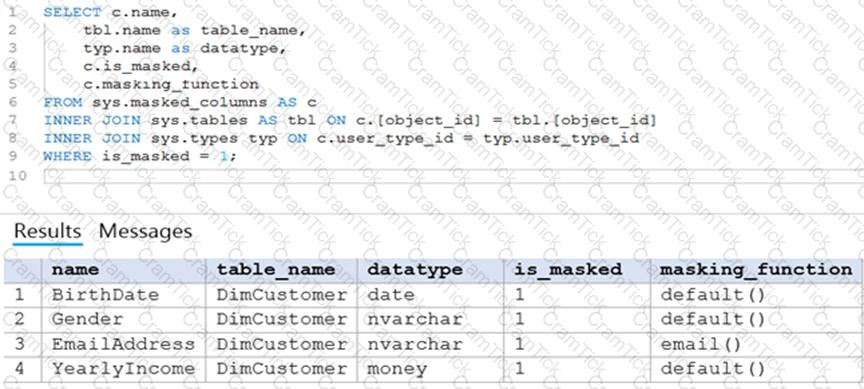
User1 is the only user who has access to the unmasked data.
Use the drop-down menus to select the answer choice that completes each statement based on the information presented in the graphic.
NOTE: Each correct selection is worth one point.
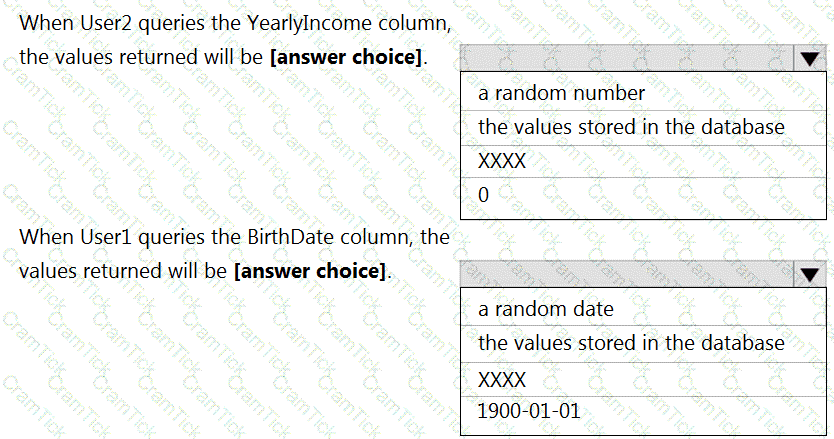
You store files in an Azure Data Lake Storage Gen2 container. The container has the storage policy shown in the following exhibit.

Use the drop-down menus to select the answer choice that completes each statement based on the information presented in the graphic.
NOTE: Each correct selection Is worth one point.

You have an Azure subscription that contains an Azure Synapse Analytics dedicated SQL pool named Pool1.
You use Azure Monitor.
You need to monitor the performance of queries executed in Pool1.
Which log should you query?
You are creating an Azure Data Factory data flow that will ingest data from a CSV file, cast columns to specified types of data, and insert the data into a table in an Azure Synapse Analytic dedicated SQL pool. The CSV file contains three columns named username, comment, and date.
The data flow already contains the following:
A source transformation.
A Derived Column transformation to set the appropriate types of data.
A sink transformation to land the data in the pool.
You need to ensure that the data flow meets the following requirements:
All valid rows must be written to the destination table.
Truncation errors in the comment column must be avoided proactively.
Any rows containing comment values that will cause truncation errors upon insert must be written to a file in blob storage.
Which two actions should you perform? Each correct answer presents part of the solution.
NOTE: Each correct selection is worth one point.
You have an Azure Databricks workspace and an Azure Data Lake Storage Gen2 account named storage!
New files are uploaded daily to storage1.
• Incrementally process new files as they are upkorage1 as a structured streaming source. The solution must meet the following requirements:
• Minimize implementation and maintenance effort.
• Minimize the cost of processing millions of files.
• Support schema inference and schema drift.
Which should you include in the recommendation?
You use Azure Data Factory to prepare data to be queried by Azure Synapse Analytics serverless SQL pools.
Files are initially ingested into an Azure Data Lake Storage Gen2 account as 10 small JSON files. Each file contains the same data attributes and data from a subsidiary of your company.
You need to move the files to a different folder and transform the data to meet the following requirements:
Provide the fastest possible query times.
Automatically infer the schema from the underlying files.
How should you configure the Data Factory copy activity? To answer, select the appropriate options in the answer area.
NOTE: Each correct selection is worth one point.
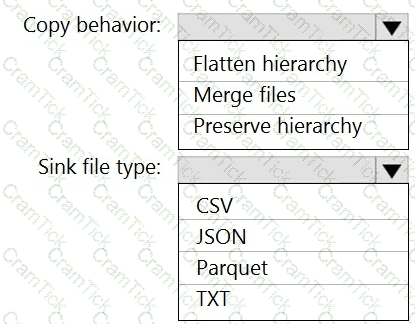
You plan to monitor an Azure data factory by using the Monitor & Manage app.
You need to identify the status and duration of activities that reference a table in a source database.
Which three actions should you perform in sequence? To answer, move the actions from the list of actions to the answer are and arrange them in the correct order.
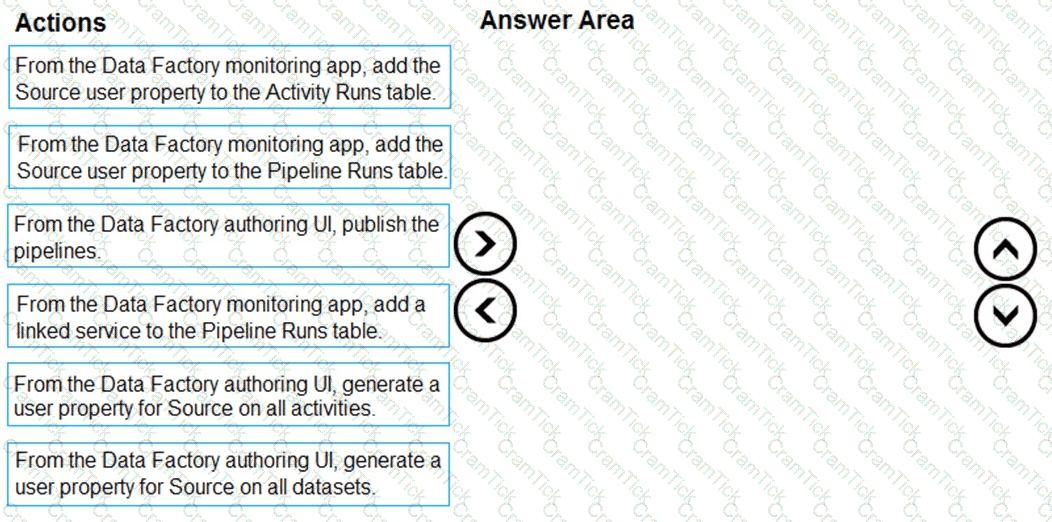
You need to create an Azure Data Factory pipeline to process data for the following three departments at your company: Ecommerce, retail, and wholesale. The solution must ensure that data can also be processed for the entire company.
How should you complete the Data Factory data flow script? To answer, drag the appropriate values to the correct targets. Each value may be used once, more than once, or not at all. You may need to drag the split bar between panes or scroll to view content.
NOTE: Each correct selection is worth one point.

You have an Azure subscription that contains an Azure Data Factory data pipeline named Pipeline1, a Log Analytics workspace named LA1, and a storage account named account1.
You need to retain pipeline-run data for 90 days. The solution must meet the following requirements:
• The pipeline-run data must be removed automatically after 90 days.
• Ongoing costs must be minimized.
Which two actions should you perform? Each correct answer presents part of the solution. NOTE: Each correct selection is worth one point.
You are designing a streaming data solution that will ingest variable volumes of data.
You need to ensure that you can change the partition count after creation.
Which service should you use to ingest the data?
You have an Azure subscription that contains an Azure Synapse Analytics account. The account is integrated with an Azure Repos repository named Repo1 and contains a pipeline named Pipeline1. Repo1 contains the branches shown in the following table.

From featuredev, you develop and test changes to Pipeline1. You need to publish the changes. What should you do first?
You have an Azure Synapse Analytics dedicated SQL Pool1. Pool1 contains a partitioned fact table named dbo.Sales and a staging table named stg.Sales that has the matching table and partition definitions.
You need to overwrite the content of the first partition in dbo.Sales with the content of the same partition in stg.Sales. The solution must minimize load times.
What should you do?
You are creating dimensions for a data warehouse in an Azure Synapse Analytics dedicated SQL pool.
You create a table by using the Transact-SQL statement shown in the following exhibit.
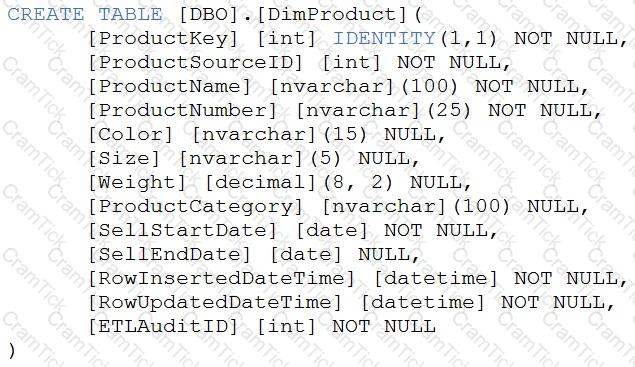
Use the drop-down menus to select the answer choice that completes each statement based on the information presented in the graphic.
NOTE: Each correct selection is worth one point.
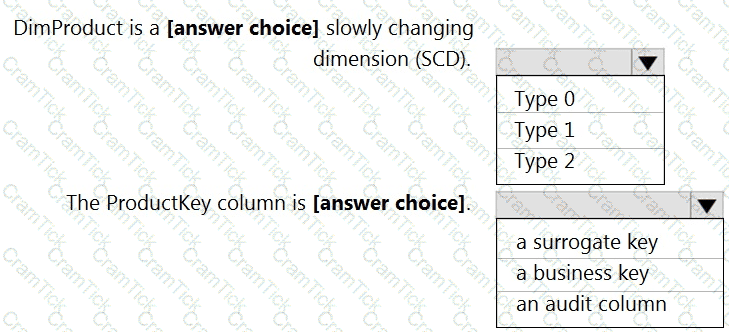
You use Azure Data Lake Storage Gen2.
You need to ensure that workloads can use filter predicates and column projections to filter data at the time the data is read from disk.
Which two actions should you perform? Each correct answer presents part of the solution.
NOTE: Each correct selection is worth one point.
You have an Azure Synapse Analytics dedicated SQL pool.
You need to Create a fact table named Table1 that will store sales data from the last three years. The solution must be optimized for the following query operations:
Show order counts by week.
• Calculate sales totals by region.
• Calculate sales totals by product.
• Find all the orders from a given month.
Which data should you use to partition Table1?
You are designing an inventory updates table in an Azure Synapse Analytics dedicated SQL pool. The table will have a clustered columnstore index and will include the following columns:

You identify the following usage patterns:
Analysts will most commonly analyze transactions for a warehouse.
Queries will summarize by product category type, date, and/or inventory event type.
You need to recommend a partition strategy for the table to minimize query times.
On which column should you partition the table?
You develop data engineering solutions for a company.
A project requires the deployment of data to Azure Data Lake Storage.
You need to implement role-based access control (RBAC) so that project members can manage the Azure Data Lake Storage resources.
Which three actions should you perform? Each correct answer presents part of the solution.
NOTE: Each correct selection is worth one point.
You have an Azure Data Factory pipeline that has the activities shown in the following exhibit.
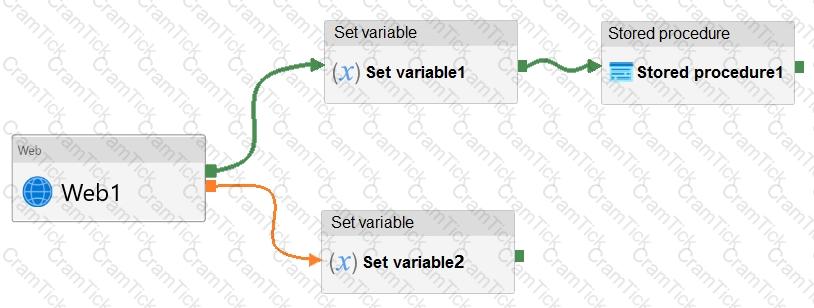
Use the drop-down menus to select the answer choice that completes each statement based on the information presented in the graphic.
NOTE: Each correct selection is worth one point.

You have an enterprise-wide Azure Data Lake Storage Gen2 account. The data lake is accessible only through an Azure virtual network named VNET1.
You are building a SQL pool in Azure Synapse that will use data from the data lake.
Your company has a sales team. All the members of the sales team are in an Azure Active Directory group named Sales. POSIX controls are used to assign the Sales group access to the files in the data lake.
You plan to load data to the SQL pool every hour.
You need to ensure that the SQL pool can load the sales data from the data lake.
Which three actions should you perform? Each correct answer presents part of the solution.
NOTE: Each area selection is worth one point.
You are designing a real-time dashboard solution that will visualize streaming data from remote sensors that connect to the internet. The streaming data must be aggregated to show the average value of each 10-second interval. The data will be discarded after being displayed in the dashboard.
The solution will use Azure Stream Analytics and must meet the following requirements:
Minimize latency from an Azure Event hub to the dashboard.
Minimize the required storage.
Minimize development effort.
What should you include in the solution? To answer, select the appropriate options in the answer area.
NOTE: Each correct selection is worth one point
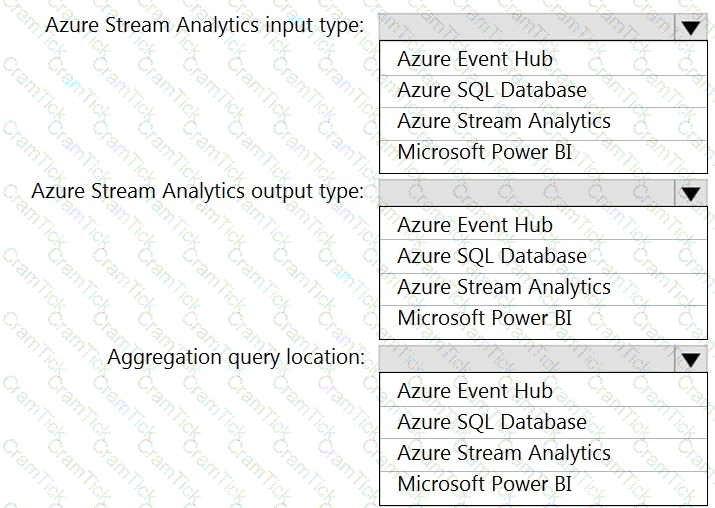
You are designing an Azure Synapse Analytics workspace.
You need to recommend a solution to provide double encryption of all the data at rest.
Which two components should you include in the recommendation? Each coned answer presents part of the solution
NOTE: Each correct selection is worth one point.
Vou have an Azure Synapse Analytics dedicated SQL pool.
You need to create a copy of the data warehouse and make the copy available for 28 days. The solution must minimize costs.
Which three actions should you perform in sequence? To answer, move the appropriate actions from the list of actions to the answer area and arrange them in the correct order.

You have an Azure Storage account and a data warehouse in Azure Synapse Analytics in the UK South region.
You need to copy blob data from the storage account to the data warehouse by using Azure Data Factory. The solution must meet the following requirements:
Ensure that the data remains in the UK South region at all times.
Minimize administrative effort.
Which type of integration runtime should you use?
You have an Azure Synapse Analytics pipeline named pipeline1 that has concurrency set to 1.
To run pipeline 1, you create a new trigger as shown in the following exhibit.
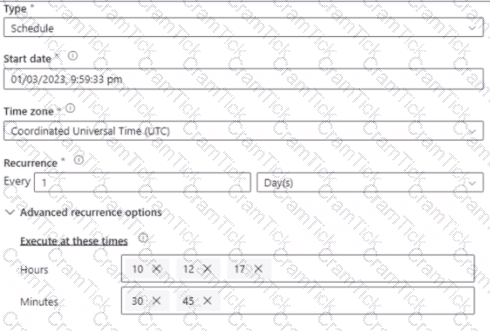
Use the drop-down menus to select the answer choice that completes each statement based on the information presented in the [graphic.
NOTE: Each correct selection is worth one point.

You are building an Azure Synapse Analytics dedicated SQL pool that will contain a fact table for transactions from the first half of the year 2020.
You need to ensure that the table meets the following requirements:
Minimizes the processing time to delete data that is older than 10 years
Minimizes the I/O for queries that use year-to-date values
How should you complete the Transact-SQL statement? To answer, select the appropriate options in the answer area.
NOTE: Each correct selection is worth one point.
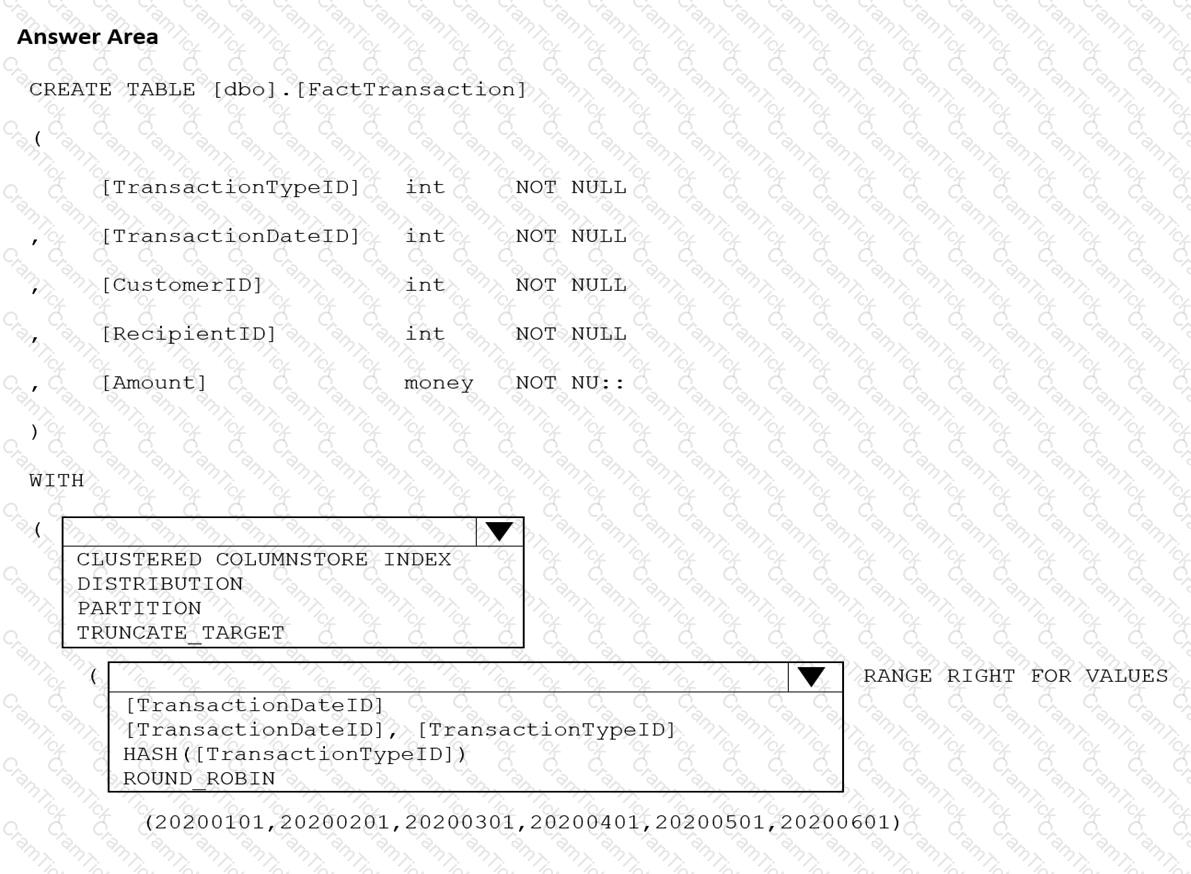
Note: This question is part of a series of questions that present the same scenario. Each question in the series contains a unique solution that might meet the stated goals. Some question sets might have more than one correct solution, while others might not have a correct solution.
After you answer a question in this section, you will NOT be able to return to it. As a result, these questions will not appear in the review screen.
You plan to create an Azure Databricks workspace that has a tiered structure. The workspace will contain the following three workloads:
A workload for data engineers who will use Python and SQL.
A workload for jobs that will run notebooks that use Python, Scala, and SOL.
A workload that data scientists will use to perform ad hoc analysis in Scala and R.
The enterprise architecture team at your company identifies the following standards for Databricks environments:
The data engineers must share a cluster.
The job cluster will be managed by using a request process whereby data scientists and data engineers provide packaged notebooks for deployment to the cluster.
All the data scientists must be assigned their own cluster that terminates automatically after 120 minutes of inactivity. Currently, there are three data scientists.
You need to create the Databricks clusters for the workloads.
Solution: You create a Standard cluster for each data scientist, a High Concurrency cluster for the data engineers, and a High Concurrency cluster for the jobs.
Does this meet the goal?
You have an Azure subscription that contains an Azure data factory.
You are editing an Azure Data Factory activity JSON.
The script needs to copy a file from Azure Blob Storage to multiple destinations. The solution must ensure that the source and destination files have consistent folder paths.
How should you complete the script? To answer, drag the appropriate values to the correct targets Each value may be used once, more than once, or not at all You may need to drag the split bar between panes or scroll to view content.
NOTE: Each correct selection is worth one point
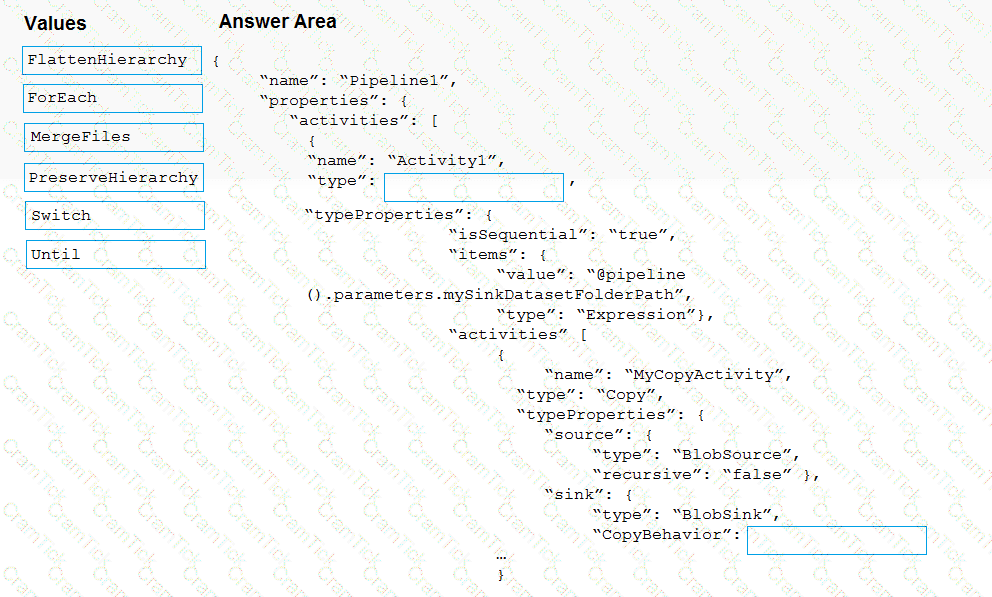
You have an Azure subscription that contains an Azure Databricks workspace named databricks1 and an Azure Synapse Analytics workspace named synapse1. The synapse1 workspace contains an Apache Spark pool named pool1.
You need to share an Apache Hive catalog of pool1 with databricks1.
What should you do? To answer, select the appropriate options in the answer area.
NOTE: Each correct selection is worth one point.

You are developing a solution using a Lambda architecture on Microsoft Azure.
The data at test layer must meet the following requirements:
Data storage:
•Serve as a repository (or high volumes of large files in various formats.
•Implement optimized storage for big data analytics workloads.
•Ensure that data can be organized using a hierarchical structure.
Batch processing:
•Use a managed solution for in-memory computation processing.
•Natively support Scala, Python, and R programming languages.
•Provide the ability to resize and terminate the cluster automatically.
Analytical data store:
•Support parallel processing.
•Use columnar storage.
•Support SQL-based languages.
You need to identify the correct technologies to build the Lambda architecture.
Which technologies should you use? To answer, select the appropriate options in the answer area
NOTE: Each correct selection is worth one point.
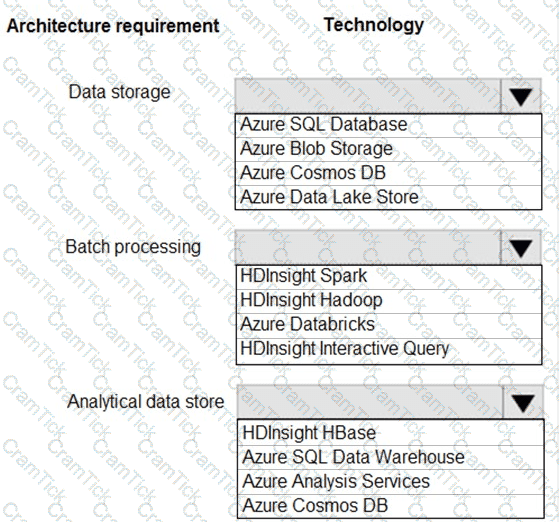
You have an Azure data factory.
You need to ensure that pipeline-run data is retained for 120 days. The solution must ensure that you can query the data by using the Kusto query language.
Which four actions should you perform in sequence? To answer, move the appropriate actions from the list of actions to the answer area and arrange them in the correct order.
NOTE: More than one order of answer choices is correct. You will receive credit for any of the correct orders you select.
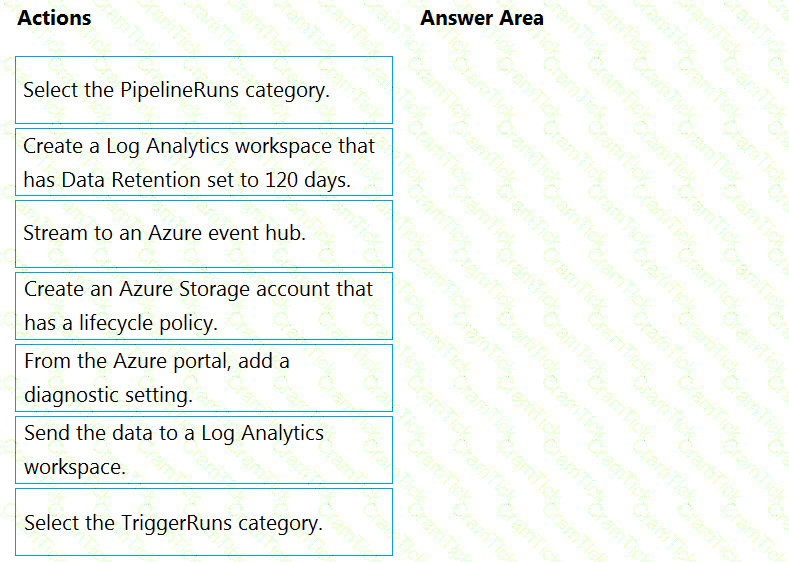
You have an Azure Data Lake Storage account that has a virtual network service endpoint configured.
You plan to use Azure Data Factory to extract data from the Data Lake Storage account. The data will then be loaded to a data warehouse in Azure Synapse Analytics by using PolyBase.
Which authentication method should you use to access Data Lake Storage?
You are batch loading a table in an Azure Synapse Analytics dedicated SQL pool.
You need to load data from a staging table to the target table. The solution must ensure that if an error occurs while loading the data to the target table, all the inserts in that batch are undone.
How should you complete the Transact-SQL code? To answer, drag the appropriate values to the correct targets. Each value may be used once, more than once, or not at all. You may need to drag the split bar between panes or scroll to view content.
NOTE Each correct selection is worth one point.
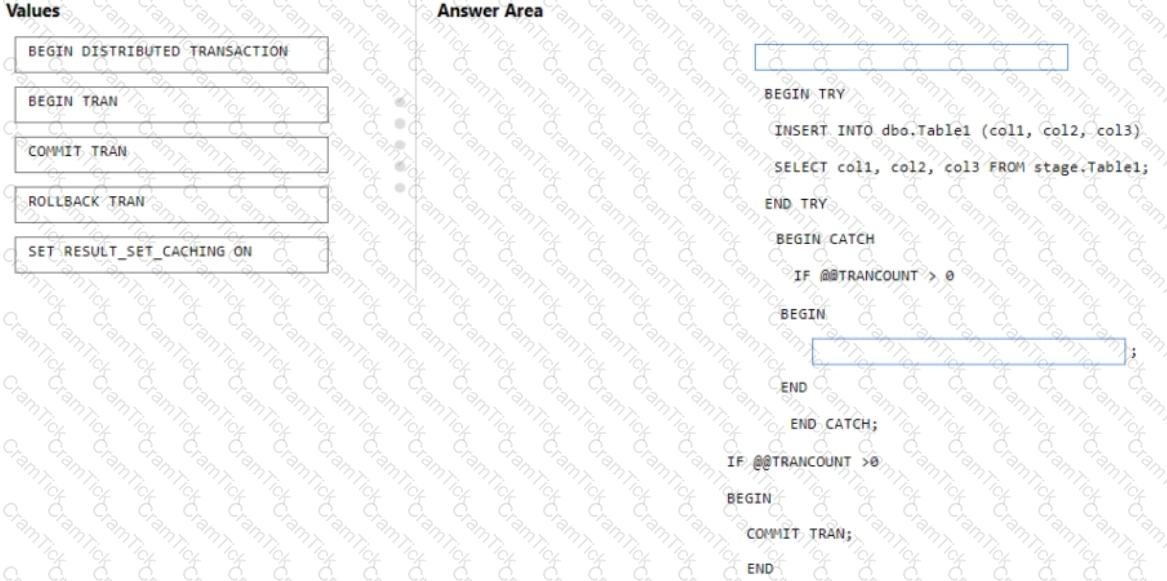
You have an Azure Data Factory that contains 10 pipelines.
You need to label each pipeline with its main purpose of either ingest, transform, or load. The labels must be available for grouping and filtering when using the monitoring experience in Data Factory.
What should you add to each pipeline?
You have an Azure subscription that contains an Azure Data Lake Storage account named myaccount1. The myaccount1 account contains two containers named container1 and contained. The subscription is linked to an Azure Active Directory (Azure AD) tenant that contains a security group named Group1.
You need to grant Group1 read access to contamer1. The solution must use the principle of least privilege. Which role should you assign to Group1?
You have an Azure SQL database named DB1 and an Azure Data Factory data pipeline named pipeline.
From Data Factory, you configure a linked service to DB1.
In DB1, you create a stored procedure named SP1. SP1 returns a single row of data that has four columns.
You need to add an activity to pipeline to execute SP1. The solution must ensure that the values in the columns are stored as pipeline variables.
Which two types of activities can you use to execute SP1? (Refer to Data Engineering on Microsoft Azure documents or guide for Answers/Explanation available at Microsoft.com)
You need to integrate the on-premises data sources and Azure Synapse Analytics. The solution must meet the data integration requirements.
Which type of integration runtime should you use?
You need to design a data retention solution for the Twitter feed data records. The solution must meet the customer sentiment analytics requirements.
Which Azure Storage functionality should you include in the solution?
You need to implement the surrogate key for the retail store table. The solution must meet the sales transaction
dataset requirements.
What should you create?
You need to design a data ingestion and storage solution for the Twitter feeds. The solution must meet the customer sentiment analytics requirements.
What should you include in the solution? To answer, select the appropriate options in the answer area
NOTE: Each correct selection b worth one point.

You need to ensure that the Twitter feed data can be analyzed in the dedicated SQL pool. The solution must meet the customer sentiment analytics requirements.
Which three Transaction-SQL DDL commands should you run in sequence? To answer, move the appropriate commands from the list of commands to the answer area and arrange them in the correct order.
NOTE: More than one order of answer choices is correct. You will receive credit for any of the correct orders you select.

You need to design an analytical storage solution for the transactional data. The solution must meet the sales transaction dataset requirements.
What should you include in the solution? To answer, select the appropriate options in the answer area.
NOTE: Each correct selection is worth one point.
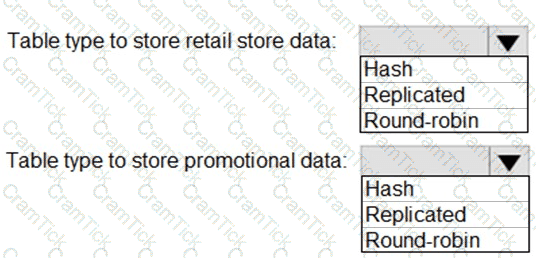
You need to implement versioned changes to the integration pipelines. The solution must meet the data integration requirements.
In which order should you perform the actions? To answer, move all actions from the list of actions to the answer area and arrange them in the correct order.
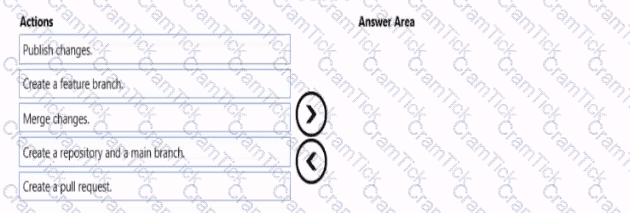
Microsoft Certified: Azure Data Engineer Associate | DP-203 Exam Topics | DP-203 Questions answers | DP-203 Test Prep | Data Engineering on Microsoft Azure Exam Questions PDF | DP-203 Online Exam | DP-203 Practice Test | DP-203 PDF | DP-203 Test Questions | DP-203 Study Material | DP-203 Exam Preparation | DP-203 Valid Dumps | DP-203 Real Questions | Microsoft Certified: Azure Data Engineer Associate DP-203 Exam Questions


